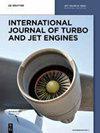Effect of velocity ratio and Mach number on thin lip coaxial jet
IF 0.9
4区 工程技术
Q4 ENGINEERING, AEROSPACE
引用次数: 0
Abstract
Abstract The effect of nozzle lip thickness and velocity ratio on coaxial subsonic jet mixing, at different Mach numbers, has been studied experimentally and numerically. Decay of coaxial subsonic jets emanating from coaxial nozzles of lip thickness 0.7, 1.7 and 2.65 mm with velocity ratio (VR) from 0.2 to 1.0 at primary jet exit Mach numbers of 0.6, 0.8 and 1.0 has been studied. Free jet without co-flow (VR0) was also studied for comparison. Jet centerline Mach number decay, turbulence and velocity variation in the radial direction are analyzed. The results show that mixing the coaxial jet at a low-velocity ratio is better than a high-velocity ratio, at all Mach numbers of the present study. The nozzle lip thickness has a significant influence on the secondary jet. Mixing of the jet in the presence of VR0.2 coaxial jet is found to be the highest. Characteristic decay of Mach 0.8 and 1.0 jet for lip thickness 1.7 and 2.65 mm is faster than lip thickness 0.7 mm. For a given lip thickness, increasing of velocity ratio is found to retard the mixing between primary and secondary jets.速度比和马赫数对薄唇同轴射流的影响
摘要 在不同马赫数下,对喷嘴唇厚和速度比对同轴亚音速射流混合的影响进行了实验和数值研究。研究了在主射流出口马赫数为 0.6、0.8 和 1.0 时,唇缘厚度分别为 0.7、1.7 和 2.65 毫米、速度比 (VR) 为 0.2 至 1.0 的同轴亚音速射流的衰减情况。为了进行比较,还研究了不带共流(VR0)的自由射流。分析了射流中心线马赫数衰减、湍流和径向速度变化。结果表明,在本研究的所有马赫数下,低速比同轴射流的混合效果都优于高速比。喷嘴唇厚对二次射流有显著影响。在有 VR0.2 同轴射流的情况下,射流的混合程度最高。唇缘厚度为 1.7 毫米和 2.65 毫米时,马赫数为 0.8 和 1.0 的射流的特征衰减速度快于唇缘厚度为 0.7 毫米的射流。在给定唇厚的情况下,速度比的增加会延缓主射流和副射流之间的混合。
本文章由计算机程序翻译,如有差异,请以英文原文为准。
求助全文
约1分钟内获得全文
求助全文
来源期刊

International Journal of Turbo & Jet-Engines
工程技术-工程:宇航
CiteScore
1.90
自引率
11.10%
发文量
36
审稿时长
6 months
期刊介绍:
The Main aim and scope of this Journal is to help improve each separate components R&D and superimpose separated results to get integrated systems by striving to reach the overall advanced design and benefits by integrating: (a) Physics, Aero, and Stealth Thermodynamics in simulations by flying unmanned or manned prototypes supported by integrated Computer Simulations based on: (b) Component R&D of: (i) Turbo and Jet-Engines, (ii) Airframe, (iii) Helmet-Aiming-Systems and Ammunition based on: (c) Anticipated New Programs Missions based on (d) IMPROVED RELIABILITY, DURABILITY, ECONOMICS, TACTICS, STRATEGIES and EDUCATION in both the civil and military domains of Turbo and Jet Engines.
The International Journal of Turbo & Jet Engines is devoted to cutting edge research in theory and design of propagation of jet aircraft. It serves as an international publication organ for new ideas, insights and results from industry and academic research on thermodynamics, combustion, behavior of related materials at high temperatures, turbine and engine design, thrust vectoring and flight control as well as energy and environmental issues.
 求助内容:
求助内容: 应助结果提醒方式:
应助结果提醒方式:


